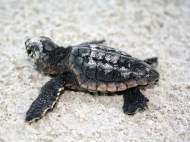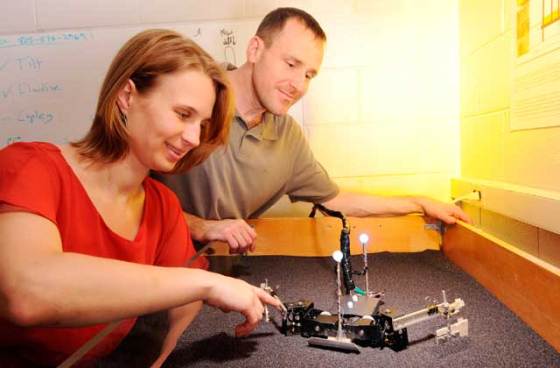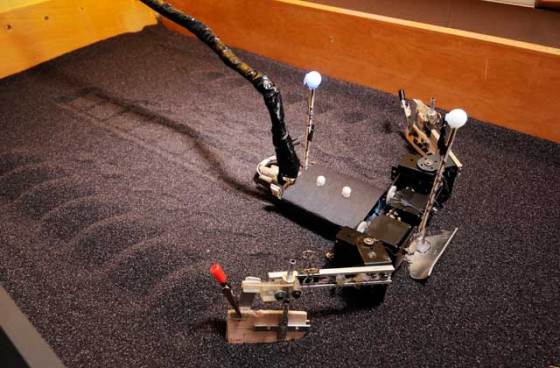FlipperBot robot locomotion inspired by sea turtle hatchlings
 Collaboration in an interdisciplinary team of researchers at Georgia Institute of Technology (Georgia Tech), Northwestern University and Temple University led to development of a robot inspired by sea turtle hatchlings. Named FlipperBot, the robot is being developed for better understanding of principles that govern movement using flippers – thus leading to more efficient robots that both swim through water and walk on land.
Collaboration in an interdisciplinary team of researchers at Georgia Institute of Technology (Georgia Tech), Northwestern University and Temple University led to development of a robot inspired by sea turtle hatchlings. Named FlipperBot, the robot is being developed for better understanding of principles that govern movement using flippers – thus leading to more efficient robots that both swim through water and walk on land.
Although turtles are usually being depicted as slow, they are pretty fast swimmers and some turtles can run fast for their size. In their struggle to reach the ocean, sea turtle hatchlings have to dig their way out from the sand where they are hatched, and use their flippers to run into the water.
Turtle hatchling research
The research began in 2010 in collaboration with the Georgia Sea Turtle Center. It started with a six-week study of hatchling loggerhead sea turtles emerging at night from nests on Jekyll Island, one of Georgia’s coastal islands. Nicole Mazouchova, then a graduate student in the Georgia Tech School of Biology, studied the baby turtles by using a LED light that simulated the moon and a trackway filled with beach sand and housed in a truck parked near the beach. She recorded kinematic and biomechanical data as the turtles moved in darkness toward an.
Mazouchova and Daniel Goldman, an associate professor in the School of Physics at the Georgia Tech, studied data from the 25 hatchlings, and were surprised to learn that they managed to achieve had comparable performance when they were running on hard ground or soft sand. The key to maintaining performance seemed to be the ability of the hatchlings to control their wrists, allowing them to change how they used their flippers under different sand conditions.
FlipperBot and moving on sand and other granular media
With assistance from Paul Umbanhowar, a research associate professor at Northwestern University, the results from hatchling research were used to develop FlipperBot. Current version of the robot is about 19 cm (7.48 inches) long, weighs about 970 grams (2.14 pounds), and has two flippers driven by servo-motors.
Like the turtles, the robot has flexible wrists that allow variations in its movement. Mazouchova, now a Ph.D. student at Temple University, studied many variations of gait and wrist position and found that the free-moving mechanical wrist enables movement without slipping. The wrist flexibility minimizes material yielding, which disturbs less ground. The flexible wrist also allows both the robot and turtles to maintain a high angle of attack for their bodies, which reduces performance-impeding drag from belly friction.
To move through a track bed filled with poppy seeds that simulate sand, the robot lifts its flippers up, drops them into the seeds, then moves the flippers backward to propel itself. The researchers also noted that the robot often failed when limbs encountered material that the same limbs had already disturbed. That led them to re-examine the data collected on the hatchling turtles, some of which had also experienced difficulty walking across the soft sand.
“When we saw the turtles moving poorly, they appeared to be suffering from the same failure mode that we saw in the robot”, said Goldman. “When they interacted with materials that had been previously disturbed, they tended to lose performance.”
Mazouchova and Goldman then worked with Umbanhowar to model the robot’s performance in order to predict how turtle hatchlings respond to different conditions. The predictions closely matched what was actually observed, thus enabling successful biomimicry of the animal.
“A multi-modal robot might need to use paddles for swimming in water, but it might also need to walk in an effective way on the beach”, said Goldman. “This work can provide fundamental information on what makes flippers good or bad. This information could give robot designers clues to appendage designs and control techniques for robots moving in these environments.”
For more information, you can read the paper in Bioinspiration & Biomimetics: “Flipper-driven terrestrial locomotion of a sea turtle-inspired robot” (1.68MB PDF).











Leave your response!